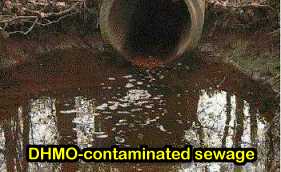 |
 |
|
Environmental Impact of Dihydrogen Monoxide
Due in part to its widespread use in industry, Dihydrogen Monoxide (DHMO) is involved in many environmental incidents each year. While most are unavoidable given current technology, there can be little doubt that the presence of DHMO in each significantly increases the negative impact to the environment.

Among the many commonly-sited DHMO-related environmental impacts are:
- DHMO contributes to global warming and the "Greenhouse Effect", and is one of the so-called "greenhouse gasses."
- DHMO is an "enabling component" of acid rain -- in the absence of sufficient quantities of DHMO, acid rain is not a problem.
- DHMO is a causative agent in most instances of soil erosion -- sufficiently high levels of DHMO exacerbate the negative effects of soil erosion.
- DHMO is present in high levels nearly every creek, stream, pond, river, lake and reservoir in the U.S. and around the world.
- Measurable levels of DHMO have been verified in ice samples taken from both the Arctic and Antarctic ice caps.
- Recent massive DHMO exposures have lead to the loss of life and destruction of property in California, the Mid-West, the Philippines, and a number of islands in the Caribbean, to name just a few.
- Research has shown that significant levels of DHMO were found in the devastating Indian Ocean tsunami in 2004 which killed 230,000 in Indonesia, Thailand, Malaysia and elsewhere, making it the deadliest tsunami in recorded history.
- It is widely believed that the levee failures, flooding and the widespread destruction resulting from Hurricane Katrina along the U.S. Gulf Coast in 2005 were caused or exacerbated by excessive DHMO levels found in the Gulf of Mexico, along with other contributing factors.
Industrial DHMO Dumping
In spite of the recent movement to ban unlawful dumping of hazardous chemicals into waterways in the U.S. and abroad, release of massive quantities of DHMO continues. Industry cannot be held accountable entirely because lawmakers are reluctant to pass legislation to make most forms of dumping of DHMO illegal. Reasons for this could include pressures from corporate leaders, industry lobbyists, and even vested foreign governments. This governmental inaction leading to nearly unregulated dumping may be one of the most overlooked environmental impacts of DHMO.Meanwhile, federal (EPA) regulations are in place to make illegal the disposal of DHMO in landfills, including those licensed for hazardous waste. Regulations also stipulate that any DHMO appearing in a landfill must be removed. Judging from these laws it appears that the U.S. government recognizes the inherent danger DHMO poses to the environment, at least in certain circumstances.
The U.S. government refuses to ban the production, distribution, and use of DHMO. This inaction may be due to pressures from private interests and corporate-sponsored economists, among many, who predict a DHMO ban could produce disastrous results. Claims include damage to public health and the well-being of the U.S. and world economies.
Fortunately, some industry and governmental leaders are taking the initiative to inform and educate their employees in spite of what the U.S. government's official policy may be. Major employers, such as Sandia National Laboratories, a national security laboratory operated by the Sandia Corporation, a Lockheed Martin Co., for the U.S. Department of Energy, have begun notifying their workers of the DHMO issue. With efforts such as those at Sandia, the proliferation of DHMO may one day be minimized.
Equally encouraging is the support of environmental organizations, such as the Green Party of Aotearoa New Zealand, an important force in the southern hemisphere promoting "ecological wisdom, social responsibility, appropriate decision-making and non-violence." Notably, a busy high-ranking Member of Parliament there supports a ban on DHMO. This welcome endorsement serves as a reminder to a pre-occupied world that fostering a widespread knowledge of DHMO is crucial.
Copyright © by Tom Way